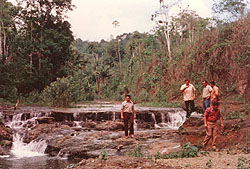

AQUIFER-PERFORMANCE TEST OF THE RIO VALDIVIA ALLUVIAL AQUIFER AT CARRIZAL, ECUADOR, S.A.
William M. Turner, Ph.D.
|
|
APT DESIGN
The production well was drilled many years ago but had never been put into production. The well was constructed of blank 20-inch (50.8 cm) diameter casing set to a depth of about 16 feet (5 m) followed by 144 feet (44 m) of 20-inch (50.8 cm) diameter, machine-slotted, filter-pipe. The string of filter-pipe and casing was gravel packed to the land surface.
Because the water table in the river channel was close to the land surface at the time of the test, observation wells were constructed from lengths of 1/2-inch (0.02 cm) diameter, galvanized steel pipe. The pipes were slotted by hacksaw, and one end of each pipe was flattened to form a drive point. The pipes were driven into the aquifer with a jackhammer. We reasoned that, not only were the observation points inexpensive, but the small amount of water storage in them would eliminate well-bore storage effects.
We installed a 6-inch (15.2 cm) diameter, 1,600-foot (500 m) pipeline to the south of the pumped well to prevent the pumped water from reentering the aquifer in the vicinity test. The pipeline terminated at a network of irrigation ditches which conveyed the produced water another 1,600 feet (500 m) to the south before returning it to the aquifer.
PRE-TEST DATA COLLECTION
AGW hydrogeologists conducted a short-duration, constant-discharge, aquifer-performance test (APT) using the Carrizal well to estimate the aquifer transmissivity and a reasonable pumping rate for a large capacity, long-term test. We measured drawdown with an etched steel tape graduated in l00ths of a foot. We made out measurements within a 1/2-inch-diameter (1.27 cm) polyethylene tube suspended in the production well.
We measured the pumping rate volumetrically with a 3-gallon (11.4 l/s) bucket and a Clebar stopwatch graduated in l00ths of a second. We analyzed the time-drawdown data using the Jacob, quasi-steady state, straight-line method. Based on this test, we decided to pump the control well at 500 gpm (31.6 l/s).
We evaluated the ground-water-level response times of the observation wells by introducing one-half liter of water into each observation well and measuring the time required to reestablish the pre-injection water level. In all cases, original water levels were reestablished within 30 seconds. We believe response of each of the observation wells was satisfactory.
We measured water-level measurements in the production well over a period of 16 days prior to initiation of the aquifer-performance test. The average rise in water level immediately prior to the test was 0.090 ft/day (0.03 m/day).
THE TEST
We installed three pumps, each with a maximum, rated capacity of less than 200 gpm (12.6 l/s) in the well. We controlled the discharge from each pump with a 3-inch gate valve. The pumps were powered by a 3 kilowatt, 220-volt, 3-phase generator. We turned on the first pump in the control well and it immediately became apparent that the well could sustain a pumping rate of only 60 gpm (3.8 l/s). This test was terminated after 3 hours 33 minutes. We turned on only on pump 15 minutes later and its discharge rate was maintained at 60 gpm (3.8 l/s). The terminated the test 1,082 minutes later because maintenance was required on the generator. We obtained sufficient drawdown data for analysis from all of the observation wells during the test.
DATA ANALYSIS
We plotted the data from the observation wells on 2-cycle logarithmic paper. We analyzed the data using the Theis, transient state, non-equilibrium method. Vertical ground-water flow in the vicinity of the control and observation wells is negligible. Aquifer parameters determined from the tests are tabulated in Table 1.
Table 1. Summary of aquifer parameters determined
from the aquifer-performance test at Carrizal.Well Date of Test Method Transmissivity (gpd/ft) (m2/d) Storage Coefficient Production
6/25/74
Jacob
37,889
471
2A
7/11/74
Theis
37,999
472
0.047
3
7/11/74
Theis
41,256
512
.110
4A
7/11/74
Theis
63,030
783
.058
5A
7/11/74
Theis
40,747
506
.048
CONCLUSIONS
Our analysis of the data indicates the average aquifer transmissivity is about 40,000 gpd/ft (497 m2/d) and the average specific yield is about 0.05. We conclude the aquifer is thin and will not yield water at high rates because drawdown caused by pumping significantly reduces the saturated thickness in the vicinity of the well. Our conclusion was subsequently verified by a thermal injection test of the well.
If ground water is to be developed in the Valdivia valley, well points, shallow hand-dug wells, Ranney-type collector wells, or infiltration galleries will be required.
VERIFICATION
A British Overseas Geological Survey hydrologist convinced EMAP that the pumping well and the observation wells had not been drilled and constructed properly. EMAP subsequently drilled and constructed (at very considerable expense) two, large-diameter, test wells and a co-linear network of eight observation wells equipped with automatic water-level recorders about two kilometers downstream from Carrizal near the village of Barcelona. Aquifer-performance tests using the two test wells were carried out by personnel of the British Overseas Geological Survey. The conclusions reached were that water from the aquifer was best produced by well points or an infiltration gallery. These conclusions agreed with the conclusions reached earlier by AGW scientists, using common-sense, small-diameter, observation-well installation, and a thermal injection test for a fraction of the cost.
? 1999-2016 AGW Consultants. All Rights Reserved.
 Hydrogeologists in the Rio
Valdivia
Hydrogeologists in the Rio
Valdivia